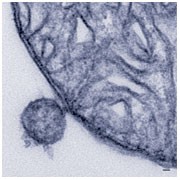
Mitochondria–peroxisome connection
- Select a language for the TTS:
- UK English Female
- UK English Male
- US English Female
- US English Male
- Australian Female
- Australian Male
- Language selected: (auto detect) - EN
Play all audios:

Access through your institution Buy or subscribe The authors were interested in identifying proteins that regulate mitochondrial morphology. Because this morphology can be regulated by
ubiquitylation and sumoylation, they used a bioinformatics screen to search for candidate ubiquitin or small ubiquitin-like modifier (SUMO) E3 ligases that contain conserved RING domains and
are anchored into mitochondria. > An unexpected intracellular transport route between mitochondria and > peroxisomes has been identified... This is a preview of subscription content,
access via your institution ACCESS OPTIONS Access through your institution Subscribe to this journal Receive 12 print issues and online access $209.00 per year only $17.42 per issue Learn
more Buy this article * Purchase on SpringerLink * Instant access to full article PDF Buy now Prices may be subject to local taxes which are calculated during checkout ADDITIONAL ACCESS
OPTIONS: * Log in * Learn about institutional subscriptions * Read our FAQs * Contact customer support ORIGINAL RESEARCH PAPER * Neuspiel, M. et al. Cargo-selected transport from the
mitochondria to peroxisomes is mediated by vesicular carriers. _Curr. Biol._ 18, 102–108 (2008) Article CAS Google Scholar Download references Authors * Rachel Smallridge View author
publications You can also search for this author inPubMed Google Scholar RELATED LINKS RELATED LINKS WEB SITE Heidi McBride's laboratory FURTHER INFORMATION Heidi McBride's
homepage RIGHTS AND PERMISSIONS Reprints and permissions ABOUT THIS ARTICLE CITE THIS ARTICLE Smallridge, R. Mitochondria–peroxisome connection. _Nat Rev Mol Cell Biol_ 9, 187 (2008).
https://doi.org/10.1038/nrm2362 Download citation * Issue Date: March 2008 * DOI: https://doi.org/10.1038/nrm2362 SHARE THIS ARTICLE Anyone you share the following link with will be able to
read this content: Get shareable link Sorry, a shareable link is not currently available for this article. Copy to clipboard Provided by the Springer Nature SharedIt content-sharing
initiative
